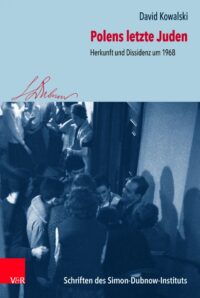
Even though all the Warsaw Pact states followed the anti-Israeli policy of the Soviet Union in connection with the Six-Day War in 1967, only the People’s Republic of Poland used this course to purge the party apparatus and public life of persons of Jewish descent. In the course of the anti-Semitic campaign of 1968, thousands of Polish citizens of Jewish origin saw themselves forced to emigrate. Despite the wealth of publications on both the opposition movement in Poland and the anti-Semitic campaign of 1968 since the 1990s, David Kowalski sees a “fundamental research gap,” since previous studies have either looked only at the opposition movement or concentrated on its Jewish aspects.
The author focuses on a group of students at Warsaw University who were active in the opposition movement of 1968 and whose members had in common that they had (mostly communist) parents of Jewish origin in more or less high professional positions. In addition, many of these young people belonged to the informal Club of Contradiction Seekers (Klub Poszukiwaczy Sprzeczności) in Warsaw in the early 1960s, where up to 60 young people (until its dissolution in 1963) met to discuss politics, philosophy and culture. Despite the fact that their Jewish origin played at most a subordinate role for the students, they shared a certain social milieu with a specific background of experience. Their socio-cultural environmental conditioning and political values are the subject of this study.
The book is based on twenty interviews conducted by the author, autobiographical texts, official documents (reports and minutes of the Interior Ministry’s Security Service, court transcripts), but also biographical texts of parents of the subjects, in which the author sees the key to his inquiry.
When in January 1968 the removal of Adam Mickiewicz’s Dziady (Ancestors, 1832) from the National Theatre’s repertoire was ordered by the Ministry of Culture, as all statements against the Tsar and the Russian authority (similar to current anti-Moscow statements) had been met with frenetic applause, the dissident Jacek Kuroń together with friends around Adam Michnik and Jan T. Gross addressed a protest to the Polish Parliament (the Sejm). With this, “the small group of rebelling communist dissidents took the national flag in their hands”—in defense of the Polish nation, the author argues. On March 8, a protest rally at the Warsaw University campus was followed by a demonstration with about 1,200 students demanding freedom of speech and assembly and condemning state repression. It was to be the start of nationwide student demonstrations. The regime reacted with police operations, arrests and smear campaigns against “activists” and “ringleaders.” Individuals were identified as “Jews,” named by name and accused of “conspiracy.”
Based on the anti-Semitic reactions of the regime press to the student protest, the author identifies a common ideological core in the then current Minister of the Interior Mieczysław Moczar (1913-1983), the pre-war fascist Bolesław Piasecki (1915-1979), who was also politically active in the People’s Republic under new premises, and the nationalist pre-war politician Roman Dmowski (1864-1939). Despite opposing positions, they agreed “that Polish affiliation is determined to a large extent by ethnicity” (p. 67). Władysław Gomułka, chairman of the Polish United Workers’ Party since 1956, also used Dmowski’s categories almost literally in 1968 (p. 66).
This development towards an argumentation for exclusion based on ethnicity in the Communist Party was diametrically opposed to the political ideas of the young opposition members, who saw themselves “in the tradition of a pluralistic and culturally shaped understanding of Polishness” (p. 97). The author points out that as early as 1964 Michnik criticized Jacek Kuron’s and Karol Modzelewski’s “Open Letter,” which denounced the discrepancy between Marxist claim and bureaucratic reality and called for a real “workers’ democracy” (which was also significant for the New Left in Western Europe and the USA), because the demand for Poland’s national independence was missing. These 1968 oppositionists, who saw in Marxism not a dogmatic system but “a living philosophical inspiration” in the sense of the philosopher Leszek Kołakowski, demanded human and civil rights and emphasized the importance of the constitutional state.
It is striking—thinks the author—that in 1968, instead of “criticizing and scandalizing the obvious anti-Semitism” (p. 155), the young opposition members refrained from addressing the subject in their leaflets. The author sees an explanation in the special political and family-related socialization of this group. Their parents had decided in favor of the communist idea, in favor of Poland and against Jewish affiliation. Nevertheless, the particularity of this milieu in the society of the People’s Republic of Poland could not be resolved. The young opposition members grew up under specific conditions that differed from those of the majority of society. These included, for instance, a different attitude towards the Soviet Union, non-affiliation with the Catholic Church and a lack of kinship networks resulting from the Holocaust. The milieu therefore remained largely self-contained. The author sees its attachment to the communist utopia in the yet unsolved minority problem of the interwar period. With the radical turning away from the Jewish way of life, they hoped to overcome the problem of Jewish particularism. Those young people (mostly from the Club of Contradiction Seekers) therefore understood their demands for more freedom rights in 1968 as universalistic.
This commendable study provides insights into the political, social and cultural characteristics of young opponents and examines the specific milieu from which their protest and demand for human and civil rights could have emerged. It becomes clear that rival concepts of “Polishness” still exist in the relationship between Polish and Jewish history. Overall, this work provides new insights into the character of the student protests of 1968 in Poland and their long-term consequences.